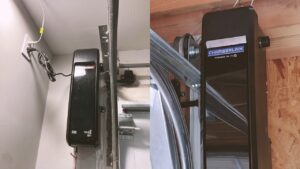As a homeowner, you no doubt understand that your garage door needs to be sturdy and secure. It is one of the primary entrances to your home, and it protects your family’s safety and valuables.
One vital component of any garage door system that makes for a well-built garage door is its track. A quality, appropriately sized track ensures your garage door functions smoothly with minimal noise for years to come.
So, why is it important to choose the right garage door track types?
If you opt for an incompatible or low-quality track, you could end up with a garage door that jams frequently or even comes off its tracks. Not only is this frustrating, but it can also lead to expensive damages, injuries, or even fatalities.
The U.S. Consumer Product Safety Commission (CPSC) has confirmed 46 garage door-related deaths of children between the ages of two and 14 since March 1982 as a result of accidents involving garage doors.
That said, choosing the right garage door track types can make all the difference in terms of your and your family’s safety, comfort, and efficiency.
In this post, we’ll share expert advice and essential information to help you choose the right garage door track type for your home in 2023. Let’s get started!
Connect With A Garage Expert
Connect with local experts, Compare quotes, Get the best price.
6 Types of Garage Door Tracks
Not all garage door tracks are created equal, which is why it is important to know the different types so you can choose the one that suits your garage’s specifications.
Let’s take a look at each type, along with some factors for consideration and tips from garage experts.
1. Standard Lift Garage Door Tracks
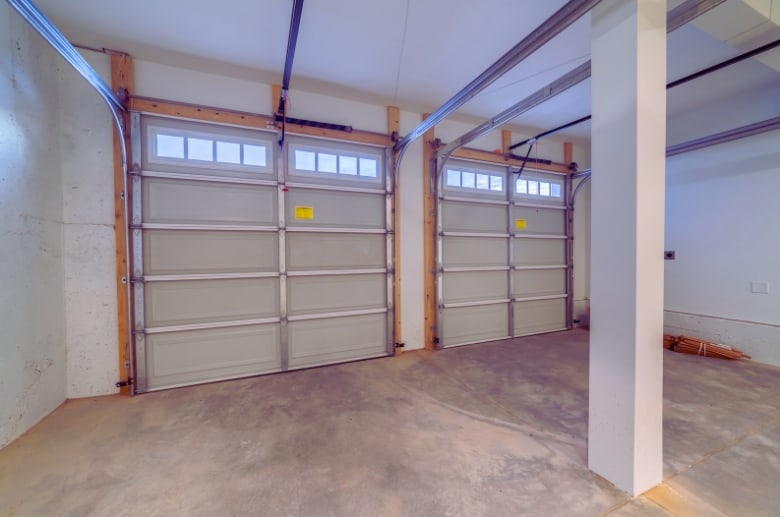
These tracks are the most commonly used type in residential homes and light commercial doors. These tracks consist of vertical tracks that run up to the ceiling and horizontal tracks that connect the vertical tracks to the ceiling. The door moves up on the vertical track, then rolls along the horizontal track as it opens.
Factors to consider when selecting this track:
- Door weight: up to approximately 350 pounds
- Door size: 7 or 12 feet overall height and 8-20 feet width
- Headroom space: minimum 6.5 or 15 inches, depending on door size
- Ceiling height: standard residential height
- Type of garage door opener: compatible with most standard garage door openers
- Space limitation: ideal for residential garages with adequate space
Garage Insiders Tip: Make sure the track is level and securely fastened to the wall. Check that the rollers smoothly glide along the track without any binding or rubbing.
2. High Lift Tracks

They are designed to maximize vertical storage space by raising the garage door closer to the ceiling. This type of track system requires more headroom clearance but can be beneficial for those with limited garage space or larger vehicles.
Factors to consider when selecting this track:
- Door weight: up to around 600 pounds
- Door size: 8.75-14 feet in height and 8-20 feet in width
- Headroom space: 12-24 inches or more
- Ceiling height: high ceilings (12 feet or higher)
- Type of garage door opener: specifically designed for high-lift openers
- Space limitation: requires additional headroom and wall space
Garage Insiders Tip: If you plan to install a car lift in your garage, high lift tracks are a great option to consider.
3. Vertical Garage Door Track
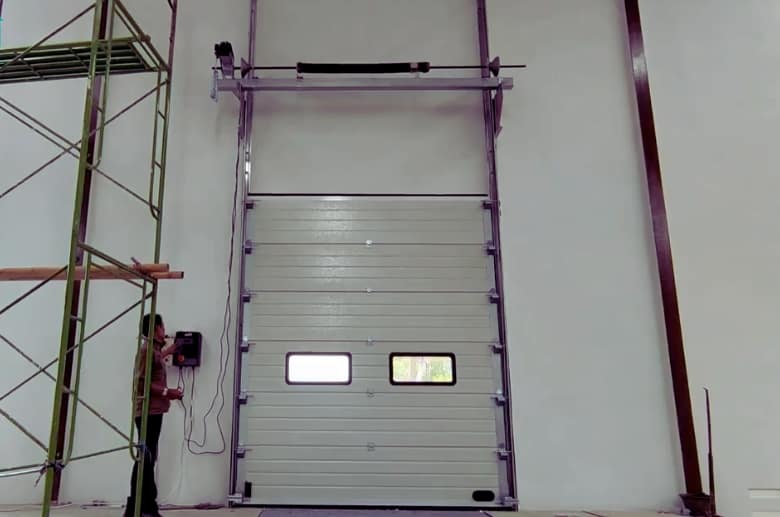
The vertical garage door track is used for commercial and heavy-duty applications where doors slide straight up and down without bending around a curve. This track system is ideal for buildings with a high ceiling, a full vertical opening, or garage spaces that don’t allow the installation of horizontal tracks.
Factors to consider when selecting this track:
- Door weight: up to around 500 pounds
- Door size: 5-8 feet in height and 8-20 feet in width; can be customized to fit larger, sectional doors.
- Headroom space: none needed
- Ceiling height: any ceiling height
- Type of garage door opener: commercial or industrial-strength
- Space limitation: requires large openings, ideal for commercial or industrial spaces with limited headroom.
Garage Insiders Tip: Because vertical tracks are intended for commercial or industrial use, they require specialized installation and should only be installed by a professional.
4. Low Headroom Tracks
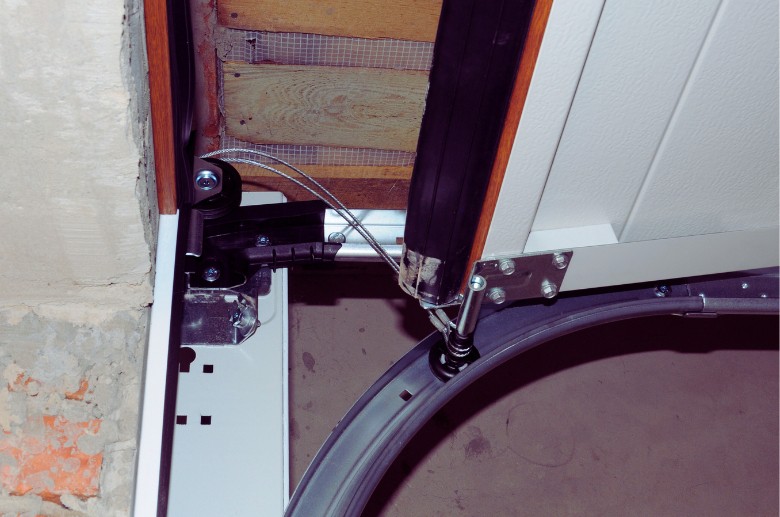
These tracks are a modified version of the standard lift system, perfect for garages with limited ceiling height. This track configuration is best for homes with low ceilings or unique garage layouts.
Factors to consider when selecting this track:
- Door weight: up to around 400 pounds
- Door size: 7-9 feet in height and 8-20 feet in width
- Headroom space: minimum 6.5-7.5 inches
- Ceiling height: specific low-headroom opener models
- Type of garage door opener: compatible with most garage door openers.
- Space limitation: primarily residential garages with low headroom
Garage Insiders Tip: If you’re installing low-headroom tracks, make sure to use a bottom bracket that can support the weight of the door and prevent it from bending or twisting.
5. Rear Torsion Low Headroom
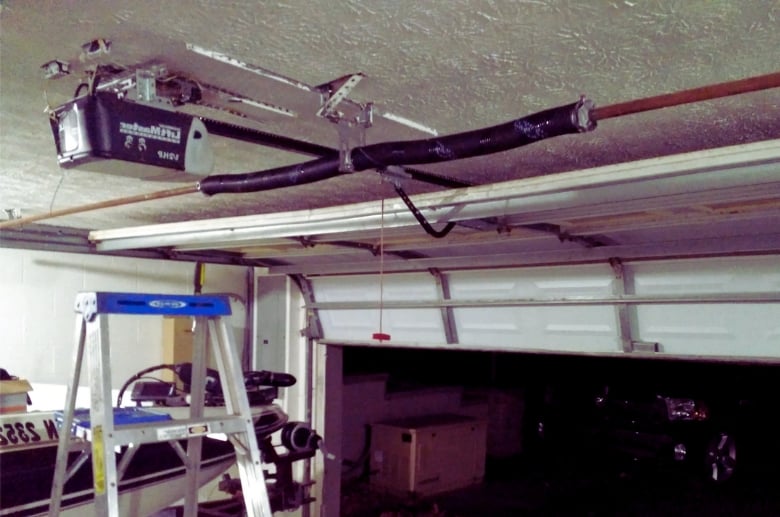
A rear torsion setup is designed for garages with limited headroom. This setup places the torsion spring assembly toward the rear of the garage, freeing up valuable space in the front.
Factors to consider when selecting this track:
- Door weight: up to around 350 pounds
- Door size: 7-9 feet in height and 8-20 feet in width
- Headroom space: minimum 4.5 inches
- Ceiling height: low ceiling garages
- Type of garage door opener: low-profile garage door openers or wall-mounted openers
- Space limitation: limited headroom space, but it may be slightly more than standard low headroom tracks.
Garage Insiders Tip: We recommend you hire a professional to install these tracks due to the complexity of the spring system and because it requires precise installation.
6. Standard Roof Pitch Tracks
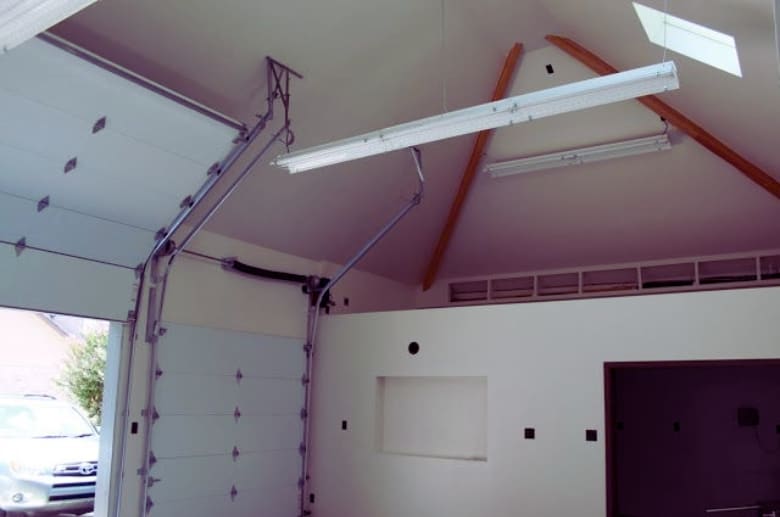
These tracks are designed for sloped roofs, and their configuration follows the angle of the roof, ensuring an optimal fit.
Factors to consider when selecting this track:
- Door weight: Compatible with doors up to 350-500 pounds
- Door size: 7-14 feet in height and 8-20 feet in width
- Roof pitch: requires a minimum slope of 1:12 but can be customized to match the specific pitch of your roof.
- Headroom Space: requires enough headroom to accommodate the incline of the tracks
- Ceiling height: any ceiling height must match the roof pitch’s angle.
- Type of garage door opener: requires specific angled track opener models
- Space limitations: it depends on the pitch of the roof.
Garage Insiders Tip: Standard roof pitch tracks are more complex to install than other types, so we recommend you hire a professional to ensure proper installation.
Connect With A Garage Expert
Connect with local experts, Compare quotes, Get the best price.
Know the Radius for Your Garage Door Tracks
The garage door radius is the distance between your door’s center and your track’s curve, and it dictates the curvature of the garage door track, influencing how it opens and closes.
Getting the correct radius is important because it ensures your garage door operates smoothly, preventing premature wear and tear on the door and the track.
Here’s a practical guideline to determine the appropriate radius for your garage door track:
- Measure your garage’s headroom (the distance from the top of the door to the ceiling).
- Refer to the aforementioned radius measurements as a starting point.
- Consult a reputable garage door expert or manufacturer to choose the best option for your specific situation.
The Impact of Radius on Garage Door Performance
A tighter radius might be suitable for smaller doors or garages with lower headroom, providing a more compact opening system. In contrast, a larger radius is ideal for larger carriages, offering a smoother, more gradual lift of the door, ultimately prolonging the life of your garage door.
The most common radius measurements (followed by door heights) are:
- 12-inch radius for 7 or 8-foot tall residential doors
- 15-inch radius for 9 to 12-foot tall commercial doors
- High-lift doors with additional vertical tracks to accommodate vehicle lifts usually require a larger 32-inch radius.
- Vertical-lift doors in warehouses and other commercial settings use 17-inch or 20-inch radius tracks.
Conclusion
In conclusion, selecting the right garage door track type is important for your garage door’s safety and efficient operation.
When you understand the specifics of your garage door track, you can set up a system that will last for years. So, always check the manufacturer’s guidelines when selecting tracks to ensure they are suitable for your garage door.
It’s true that it might seem overwhelming at first. We at Garage Insiders know this very well, but we also know that the type of garage door track you select is critical for your garage door’s operation.
If you’re still unsure about which type of garage door track to choose, don’t hesitate to call a local garage door expert to help you.



